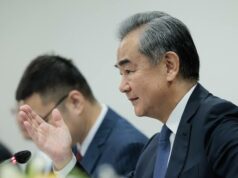The Russian Military Special Operation Forces are known as Spetsnaz. These are akin to their foreign counterparts with one major difference. Russian spetsnaz units contain two types of personnel. There are Spetsnaz volunteers from among the Careerists soldiers of the Army and also from a large number of conscripts, which is in sharp contrast to Western Countries who have all volunteer careerists in their SF. However the Russian military conscripts (18 months service only) who chose to join Spetsnaz are all volunteers and very carefully selected for this duty from a large pool of such volunteers. The Americans and NATO equate the Spetsnaz to the American Rangers.
Those who are regulars and volunteer for long term in the spetsnaz learn to make the most of the constant influx of conscript operators. Though in Operations there is a price to pay for high turnover. In Afghanistan and Chechnya the casualty rate for each tour of duty for a unit was nearly 10%.Originally Spetsnaz were organized more like massive raiding teams patterned on British Commandos of WW2.. A Spetsnaz brigade of 1,300 men could field about 100 x 8-10 man teams. A Spetsnaz company has 135 men further divided into 15 independent teams.
There are Spetsnaz in many of the Russian defence and Security organisations. Apart from the army and the navy even the national police, Foreign Ministry and intelligence services all have Spetsnaz detachments that specialize in doing what their organization requires. Thus there are Spetsnaz who can carry out amphibious operations or protect embassies and diplomats overseas. There is even a special Spetsnaz detachment of super-snipers who can also be used to find and kill exceptionally effective enemy snipers.
Like the American SF, Russian special operations troops are also trained to do a variety of missions. These include reconnaissance deep into enemy territory, provide security for very valuable people or equipment and also carry out direct action destructive missions. Russian spetsnaz did this in Afghanistan in the 1980s and in the Caucasus since the late 1990s. Details available show that In Chechnya only a few hundred spetsnaz are deployed at a time, whereas about 80 percent of total Chechen rebel casualties are caused by these spetsnaz. The spetsnaz in Chechnya(and later in Ukraine) mainly collect information on the rebels, locating their camps and travel routes. Artillery or bombers are called in to do the actual attacks. When the spetsnaz do run into rebel units, they inflicted far more casualties than they take. But relatively speaking the spetsnaz casualties are higher in Comparison with their foreign counterparts, probably because of the many conscripts. Often a third or more of the men in a spetsnaz unit in Chechnya are conscripts. Down in the Caucasus, a lot of the actual fighting was between non-Chechens (al Qaeda types) and Russian commandos (GRU Spetsnaz.) Some 80 percent of the Chechen casualties were inflicted by the spetsnaz teams, who are the only troops that regularly patrol the mountains where the Chechen rebels and their foreign allies hide out. Most of the dead and captured rebels are not Chechens. They are foreigners, many of them Arabs. This has largely quieted down by 2009, but the GRU spetsnaz are still doing six month tours down there. They have become very good at what they are trained to do.
During the Crimean operations in Ukraine, the GRU Spetsnaz plan included persuading many of them to either just not fight but to accept a generous offer to join the Russian armed forces. The 11,000 Russian troops normally stationed in Crimea were mostly support personnel for the naval bases of the Black Sea Fleet. The 2,000 marines present were soon reinforced by another 7,000 troops, mostly infantry and special operations forces. These were followed by 15,000 more ferried across the 4.5 kilometer wide Kerch Strait that separates Crimea from southern Russia. Soon Russia forces numbering over 30,000 troops in Crimea, included over a thousand spetsnaz.
The Crimea operation was something of a comeback for the spetsnaz who, after the sloppy Russian invasion of Georgia in 2008 were being downsized. The GRU spetsnaz previously were feeling that they were not getting the respect and good treatment they deserved in spite of spending time in hell holes like Chechnya and made worse by the fact that the FSB spetsnaz units had better fringe benefits and pay. Due the success in Crimea, the planned (since 2009) cuts to GRU Spetsnaz were rescinded. Apparently the fact that the GRU spetsnaz units had long history of successful operations (many still top secret) did count for something. The successful Crimea operation will go down as one of GRU’s biggest successes. The GRU Spetsnaz were the first (in 1957) of the spetsnaz units created and have now demonstrated that they not only can fight Islamic terrorists, but also carry out complex political operations as well. In fact GRU considers counter-terrorism ops, especially within Russia to be another form of “complex political operation.”
Therefore the Russians have moved ahead and created its newest strategic level special operations unit, the KSO (Komandovanie SilSpetsialnalnikh Operatsii). KSO came into being sometime in 2009 but little was revealed officially. KSO appears to be an elite Russian special operations unit more like the British SAS or the American Delta Force than the Rangers. KSO has fewer than a thousand personnel, most of them operators and all are volunteer professional soldiers who not only operate like their Western counterparts but have been seen using some of the same equipment. It seems that best from the GRU Spetsnaz are sent to the KSO. It also draws its personnel from all the special operations units in Russia with the assurance that they would be the best of the best and get pay, equipment, weapons and government support commensurate with that. They have been a complete Success. In 2012 the Russians also created a Special Operations Forces Command. The aim is to establish a total of 9 Special Purpose Brigades under this Command.
In Syria, it was soon obvious that Spetsnaz sent were only of the regular variety san short term conscripts. Initially it seemed that the spetsnaz apparently included some of their Syrian counterparts (especially if they spoke Russian) in spetsnaz units. It later turned out that this was part of the cover for the presence of KSO. Though they were new, KSO performed well and soon became the lead special operations unit in Syria. To avoid own casualties in Syria, now Russians just like the West are using highly skilled operators (like SAS and Delta) as a backbone or spearhead for other special operators. KSO is being used for Osama bin Laden type operations and for neutralising senior Islamic terrorist leaders and, more importantly, capture useful secrets from such targets.
It turned out that KSO was a key element in ensuring the quick takeover of Crimea work. KSO is still a threat to Ukraine but it was apparently intel and advice from KSO operatives that prevented Russia from getting into involved in eastern Ukraine (Donbas).
Russian special operations troops have been in Syria officially since October 2015 and unofficially up to a year earlier. Russia did not say much about what their operators were doing in Syria, which is standard for special operations forces. Initially the special operations forces were there to train their Syrian counterparts and help hunt down and kill ISIL (Islamic State in Iraq and the Levant) leaders. Any successes there were not publicized, which is, again, pretty standard for secretive commando operations. It was more difficult to hide the role Russian special operators played in helping improve the security around senior government officials in Damascus. That operation was also a success despite many efforts by rebels to get at the Assad family and their key allies.



